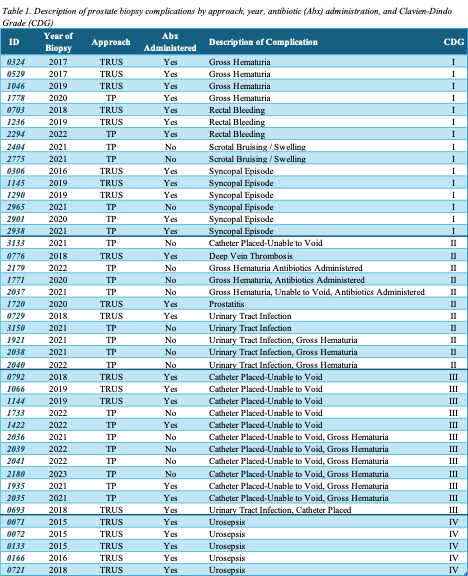BACKGROUND - Transperineal MRI/ultrasound fusion biopsies (TP) have been reported to exhibit lower complication rates and improved rates of clinically significant prostate cancer detection compared to transrectal ultrasound-guided fusion biopsies (TRUS). Despite these advantages, TRUS remains the predominant approach for prostate biopsy in the United States. Given the limited large-scale studies comparing TP and TRUS complication rates in the United States, we aimed to report post-biopsy complication rates from a single academic medical center.
METHODS -Transperineal MRI/ultrasound fusion biopsies (TP) have been reported to exhibit lower complication rates and improved rates of clinically significant prostate cancer detection compared to transrectal ultrasound-guided fusion biopsies (TRUS). Despite these advantages, TRUS remains the predominant approach for prostate biopsy in the United States. Given the limited large-scale studies comparing TP and TRUS complication rates in the United States, we aimed to report post-biopsy complication rates from a single academic medical center.
RESULTS - In the TP cohort, comprising 1880 biopsies performed on 1782 patients from 2018 to 2023, an overall complication rate of 1.23% (24 complications) and an infectious complication rate of 0.32% (4) were observed. All patients receiving TRUS biopsies received antibiotic prophylaxis, compared to 27.17% of the TP cohort. All infectious complications for TP were afebrile urinary tract infections and occurred without antibiotic administration (p > 0.05). In the TRUS cohort, consisting of 1558 biopsies performed on 1460 patients from 2014 to 2023, an overall complication rate of 1.28% (20) and an infectious complication rate of 0.45% (7) were observed. Comparison of complication rates between TP and TRUS-fusion showed no statistical significance (p > 0.05). However, TRUS cases were 11.27% more likely to have a Clavien-Dindo Grade > II (p < 0.05). Urosepsis occurred exclusively in the TRUS arm (5 cases), constituting 25.00% of all TRUS complications and occurring in 0.32% of all TRUS cases (p < 0.05).
CONCLUSIONS - Complication rates for both TP and TRUS were low. There were no significant differences in overall and infectious complication rates between the two approaches. However, TP biopsies had significantly decreased rates of CDG >2 complications and urosepsis. Therefore, TP appears to be a safer approach that minimizes antimicrobial resistance risks associated with antibiotic use. Future studies are warranted to investigate patient characteristics associated with infectious and noninfectious complications to guide antibiotic administration and post-procedure management.
